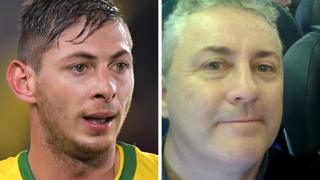
The pilot of the plane which crashed into the English Channel with Emiliano Sala on board, was not qualified to fly at night, BBC Wales understands.
David Ibbotson is thought to have been colour-blind, which prevents pilots from flying at night.
Footballer Sala, 28, died when the plane carrying him from Nantes to Cardiff crashed late on 21 January.
The UK Civil Aviation Authority (CAA) said it would not comment until the AAIB investigation was complete.
The Air Accidents Investigation Branch (AAIB) said licensing “continues to be a focus” of its investigations.
Regulatory authorities have confirmed that Mr Ibbotson, from Crowle, North Lincolnshire, did not hold a “night rating” on his UK private pilot’s licence, the BBC understands.
His UK licence was mirrored by a US pilot’s licence – enabling him to fly the US-registered Piper Malibu in Europe.
The public record of his Federal Aviation Administration (FAA) licence states Mr Ibbotson “must have available glasses for near vision” and that “all limitations and restrictions on the United Kingdom pilot licence apply”.
There is no publicly available record of UK pilot licences, which are held by the CAA.
But sources have told BBC Wales that Mr Ibbotson’s licence restricted him to “flights by day only”
“Colour-blindness stops a pilot from obtaining a night rating straight away, because being able to differentiate between green and red lights is key to flying in the dark,” an aviation source told BBC Wales.
“Anything that’s on the UK licence applies to the US licence as well, so he couldn’t do anything more than the UK licence allows.
“Flying outside the restrictions of your licence is illegal and that’s likely to affect the insurance cover for the flight.”
European aviation rules define night as “the time from half an hour after sunset until half an hour before sunrise”.
Flight plans seen by BBC Wales indicate the flight scheduled to take Argentine player Sala for his first training session with Cardiff City had been due to leave Nantes airport at 09:00 local time on 21 January.
But the flight was postponed until 19:00, at the request of Sala, to allow him to spend the day saying goodbye to his Nantes teammates.
By the time Mr Ibbotson taxied a Piper Malibu plane on to the runway ready for take-off shortly after 19:00, it would have been around an hour and 10 minutes since sunset.
Speculation about the legality of the flight has so far centred around the question of whether it complied with restrictions concerning private pilots flying passengers in Europe in a US-registered aircraft.
As a private pilot, 59-year-old Mr Ibbotson was not allowed to carry passengers for remuneration or financial reward.
A preliminary report from the AIIB, released in February, stated he could only fly passengers on a cost-share basis.
As the aircraft was US-registered, pilot and passenger must have a “common purpose” for making the journey, and the pilot must dictate when a flight leaves.
The report adds that the flight “must not be made for the purpose of merely transporting the passenger”.
In an interview in February, football agent Willie McKay, who commissioned the flight, told the BBC that he and his family paid for the flight.
He was not involved, he said, in selecting the plane or the pilot and it was not a cost-share arrangement.
The plane disappeared off radar north of Guernsey in the Channel Islands at 20:16.
Sala’s body was recovered from the wreckage of the plane in early February but Mr Ibbotson’s body has not been found.
The European Aviation Safety Agency (Easa) states that to obtain a night rating, a pilot must undergo five hours of theory and five hours of flight training.
In their preliminary report, the AAIB said that because Mr Ibbotson’s pilot licence and log book had been lost in the crash, it had not yet been able to establish what ratings he held or how many hours he had flown recently – although it was known he had completed approximately 3,700 flying hours.
Investigators would normally look to establish how many hours a pilot had flown in the last 28 and 90 days before a crash.
The AAIB is expected to publish its full report into the tragedy early in 2020.